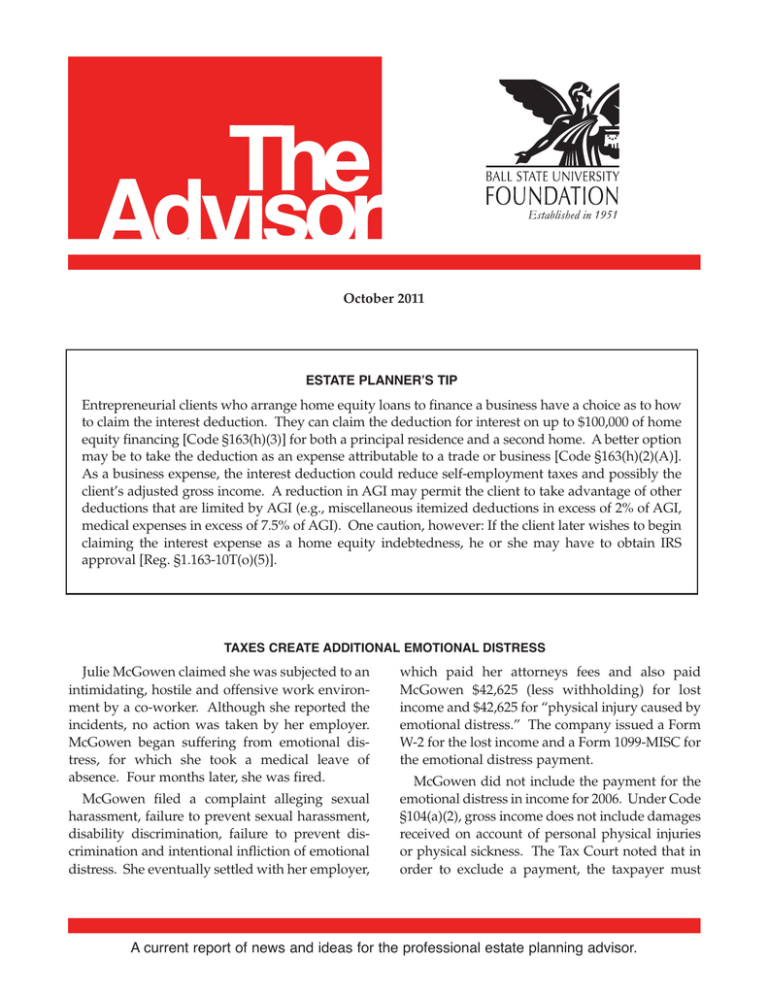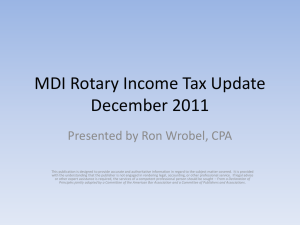The Advisor |
advertisement

The| Advisor October 2011 ESTATE PLANNER’S TIP Entrepreneurial clients who arrange home equity loans to finance a business have a choice as to how to claim the interest deduction. They can claim the deduction for interest on up to $100,000 of home equity financing [Code §163(h)(3)] for both a principal residence and a second home. A better option may be to take the deduction as an expense attributable to a trade or business [Code §163(h)(2)(A)]. As a business expense, the interest deduction could reduce self-employment taxes and possibly the client’s adjusted gross income. A reduction in AGI may permit the client to take advantage of other deductions that are limited by AGI (e.g., miscellaneous itemized deductions in excess of 2% of AGI, medical expenses in excess of 7.5% of AGI). One caution, however: If the client later wishes to begin claiming the interest expense as a home equity indebtedness, he or she may have to obtain IRS approval [Reg. §1.163-10T(o)(5)]. TAXES CREATE ADDITIONAL EMOTIONAL DISTRESS Julie McGowen claimed she was subjected to an intimidating, hostile and offensive work environment by a co-worker. Although she reported the incidents, no action was taken by her employer. McGowen began suffering from emotional distress, for which she took a medical leave of absence. Four months later, she was fired. McGowen filed a complaint alleging sexual harassment, failure to prevent sexual harassment, disability discrimination, failure to prevent discrimination and intentional infliction of emotional distress. She eventually settled with her employer, which paid her attorneys fees and also paid McGowen $42,625 (less withholding) for lost income and $42,625 for “physical injury caused by emotional distress.” The company issued a Form W-2 for the lost income and a Form 1099-MISC for the emotional distress payment. McGowen did not include the payment for the emotional distress in income for 2006. Under Code §104(a)(2), gross income does not include damages received on account of personal physical injuries or physical sickness. The Tax Court noted that in order to exclude a payment, the taxpayer must A current report of news and ideas for the professional estate planning advisor. The Advisor show that damages were received due to personal physical injury or physical sickness. Code §104(a)(2) specifically provides that emotional distress shall not be treated as a physical injury or physical sickness except to the extent that the damages were used to pay for medical care. The court found no evidence that McGowen suffered a physical injury. Therefore, the damages she received are not excludable under Code §104(a)(2), ruled the court (McGowen v. Comm’r., T.C. Memo. 2011-186). CLOCK IS TICKING Executors for estates of decedents dying in 2010 have until November 15 to elect to have carryover basis rules apply, by filing Form 8939, Allocation of Increase in Basis for Property Acquired From a Decedent. Under the Tax Relief, Unemployment Insurance Reauthorization and Job Creation Act of 2010, an irrevocable election may be made to have the carryover basis rules of Code §1022 apply to property included in the estate. No extension of time will be granted. Although the estate tax was repealed for 2010, with a modified carryover basis, the 2010 tax act allowed estates to apply the $5 million exclusion amount in effect through 2012, with full carryover basis (Notice 2011-66). PHILANTHROPY PUZZLER Melanie’s father established a private foundation at his death. Melanie plans to contribute some appreciated stock to the foundation, but a member of her book club mentioned that the charitable deduction for a gift of capital gain property to a private foundation is limited to the donor’s basis in the property, not the fair market value. Before she makes the gift, Melanie decided to inquire about the income tax deduction. What will her deduction be? WIDOWED AND TAXED Larry was unaware that his former employer required a complete distribution of retirement plan assets when participants reached age 65, until he received a check for the balance in his account. He took steps to put the money into an IRA to maintain the funds in a tax-free vehicle. Before the expiration of the 60-day rollover period under Code §402(c)(3), Larry was hospitalized and died. His wife sought to complete the rollover initiated by Larry. She asked the IRS to waive the 60-day requirement and allow her to make a rollover contribution to an IRA in her name. The IRS said that because Larry was dead, it was impossible to complete the proposed transaction. Because the distribution from Larry’s employer was received prior to Larry’s death, his wife is precluded from rolling the funds over into a tax-deferred account in her own name under Code §402(c)(9). Therefore, the IRS declined to grant a waiver of the 60-day period (Ltr. Rul. 201123048). DONOR’S GOALS SURVIVE OBSTACLES Elizabeth Lucas deeded two undivided interests in property – totaling just over 52% – to the Hawaiian Humane Society (HHS). The land was to be used “for the benefit of the public for the operation of an educational preserve for flora and fauna, to be made accessible as an educational experience for the public.” If the land was not used as specified, it was to pass to the State of Hawaii for use as a public park. When Lucas died in 1986, the remaining interest in the land passed to her family. The HHS and the state determined that, due to terrain and access issues, the land was unsuitable for any public use. A three-way land exchange and sale was proposed, under which HHS would receive about $1 million that would be used to establish a public education fund in Lucas’s name. The probate court denied the parties’ petition to approve the arrangement, saying that the cy pres doctrine did not apply, since Lucas had The Advisor provided for an alternative transfer in the deeds. COMMERCIAL ANNUITY, TRUST COMPATIBLE The Intermediate Court of Appeals of Hawaii found the cy pres doctrine did apply, noting that cy pres is applicable where a settlor creates a charitable trust of real property to be used for a specified purpose, but the property turns out to be unsuitable for that purpose. Lucas’s deeds provided an alternative charitable purpose – use of the land by the state for a public park – which showed her intent that the land be used for a charitable purpose, even if the original purpose failed. Where the alternative distribution is unfeasible, impracticable or impossible, the fact that she designated an alternative use for the land does not preclude the application of cy pres to save the first charitable purpose, said the court. Carol plans to transfer appreciated property to fund a charitable remainder annuity trust for her life. The trust would include a provision allowing the trustee discretion to use trust assets to purchase a commercial annuity that would guarantee to pay the trust a sum equal to or greater than the amount owed to Carol for her life. The trustee could only purchase an annuity from a top-rated company. Once the annuity is secured, the trustee could distribute any amount of trust corpus to the charitable remaindermen during the trust term. Where both the primary and alternative charitable distributions are impracticable, it is proper to presume that the settlor would have intended one or both purposes to survive under cy pres. The proposed use of the funds from the land exchange and sale closely conforms to Lucas’s intended purpose of providing an educational experience for the public (In re Lucas Charitable Gift, No. 30306). TOP RATINGS FOR GIFT OF LICENSES Largesse Co. purchased several low-power broadcast television station licenses in a bankruptcy sale. After it had held the licenses for one year, Largesse transferred all its rights, title and interests in five of the licenses, along with station equipment related to the licenses, to an operating foundation. The IRS determined that Largesse was entitled to a charitable deduction under Code §170(a), provided the value of the licenses is properly substantiated. The IRS found that Largesse transferred all its rights, title and interest that were held for more than one year. There is no reduction under Code §170(e), since the licenses were held more than one year and were used in a trade or business. The licenses were treated as long-term capital gain property under Code §170(e), said the IRS (Ltr. Rul. 201132011). It is expected that the trustee will purchase an annuity and that the trust would possess all incidents of ownership and be entitled to the payments. The trustee would then pay the annuity amount to Carol. Reg. §1.664-2(a)(4) provides that no amount other than the annuity interest may be paid to or for the use of any person. If an amount is transferred for full and adequate consideration, it is not considered paid to or for the use of any person. The IRS ruled that including the provision in the trust document will not prevent it from qualifying as a charitable remainder annuity trust under Code §664(d)(1) (Ltr. Rul. 201126007). PUZZLER SOLUTION Generally, the deduction for a gift of appreciated property to a private foundation is limited to the donor’s basis [Code §170(e)]. However, if Melanie gives “qualified appreciated stock,” an exception allows a charitable deduction for the fair market value of the shares [Code §170(e)(5)]. Qualified appreciated stock is defined as stock of a corporation for which market quotations are readily available on an established securities market [Code §170(e)(5)(B)]. The Advisor CHARITABLE GIFTS OF TANGIBLE PERSONAL PROPERTY Gift planning is fairly simple for clients who contribute cash or appreciated securities. Generally, the only rules that apply are the deduction limits under Code §170(b) (50% of AGI for cash gifts, 30% of AGI for gifts of appreciated property, with a five-year carryover of any excess deductions) and the substantiation requirements of Code §170(f)(8). Gifts of tangible personal property, on the other hand, may require more planning to ensure that clients receive the maximum charitable deduction. Here are some special considerations that should be addressed before making a gift: Valuation Noncash charitable gifts in excess of $500 must be reported on Form 8283, and if the value exceeds $5,000 ($10,000 for closely held stock), a qualified appraisal is required. The appraisal must be made no earlier than 60 days prior to the date of the gift and no later than the due date of the tax return. It is the obligation of the donor to pay for the appraisal. The cost may be deductible as a miscellaneous itemized deduction, not as an additional charitable gift. Donors who contribute works of art valued at $20,000 or more must submit a color photo of the item for review by the IRS’s Art Advisory Panel. Deductions The deduction for a gift of tangible personal property that is capital gain property is limited to 30% of the donor’s AGI, with a five-year carryover [Code §170(b)]. If the gift is ordinary income property (e.g., art in the hands of the artist), the deduction is limited to the donor’s basis in the property. Corporate donors often make gifts of tangible personal property. Corporations generally are entitled to charitable deductions of up to 10% of taxable income, with five-year carryovers. If the gift item is property subject to depreciation, the deduction is reduced by depreciation previously David W. Bahlmann, J.D. President/CEO taken. If the gift is ordinary income property (e.g., inventory), the corporation’s deduction is limited to basis [Code §170(e)(1)(A)]. Special deduction limits An individual who contributes appreciated assets to charity may elect, under Code §170(b)(1)(C)(iii), to reduce the deduction to the property’s basis and deduct up to 50% of AGI, rather than the usual 30%-of-AGI limit. There are enhanced deductions for companies that contribute inventory items “for the care of the ill, needy or infants” under Code §170(e)(3)(A) or make gifts of research equipment to colleges, universities and tax-exempt scientific research organizations under Code §170(e)(4). If certain criteria are met, the deduction may be increased to basis plus one-half the unrealized appreciation, up to twice the basis. Unrelated use The deduction for a gift of tangible personal property that is “unrelated” to the charitable recipient’s exempt purposes is limited to the donor’s basis or fair market value, whichever is less. For example, a coin collection contributed to a hospital might be considered an unrelated use. If the donor of personal property is required to file the appraisal portion of Form 8283 in connection with the deduction, charity is obligated to file Form 8282 (“tattletale” form) if the property is sold within three years of the gift. A sale of the property may raise the presumption that the property was unrelated to the charity’s exempt purposes [Reg. §1.170A-4(b)(3)(i)]. A deduction for fair market value will be allowed, despite a sale within three years, if, at the time of the gift, it was reasonable for the donor to believe that the property would be put to a related use. Because of the special rules that apply to gifts of tangible personal property, clients should be advised to discuss with the charity in advance of a contribution how the property will be used. BALL STATE UNIVERSITY FOUNDATION P.O. Box 672, Muncie, IN 47308 (765) 285-8312 • (765) 285-7060 FAX Toll Free (888) 235-0058 www.bsu.edu/bsufoundation Philip M. Purcell, J.D. Vice President for Planned Giving and Endowment Stewardship If you know another professional advisor who would benefit from this publication, please contact The Foundation.





